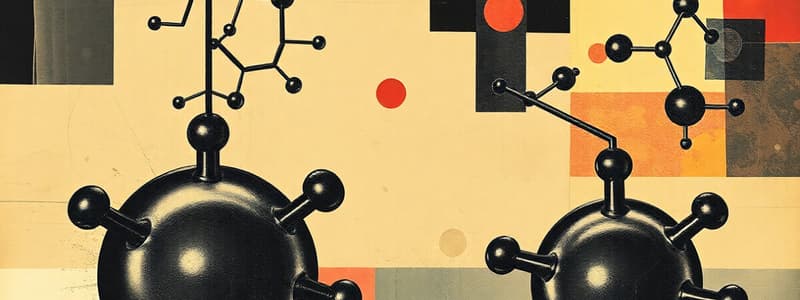Podcast
Questions and Answers
What primarily accounts for the attraction between atoms?
What primarily accounts for the attraction between atoms?
- Different behaviors of the outermost electrons (correct)
- The temperature of the environment
- The nucleus of the atom
- The weight of the atoms
What is true about the classification of chemical bonds?
What is true about the classification of chemical bonds?
- Each bond type has a distinctly separate cause
- They are classified in various ways based on consistent behavior
- They can always be clearly defined and separated
- Different types merge seamlessly in bonding situations (correct)
Why is it challenging to categorize chemical bonds?
Why is it challenging to categorize chemical bonds?
- Each bond is strictly determined by temperature alone
- Different bonding behaviors merge into each other seamlessly (correct)
- The outermost electrons behave uniformly in all cases
- There is no behavior of electrons contributing to bonding
Which of the following statements about outermost electrons is accurate?
Which of the following statements about outermost electrons is accurate?
What characterizes the relationship among different bonding behaviors?
What characterizes the relationship among different bonding behaviors?
What does the E represent in the context of VSEPR theory?
What does the E represent in the context of VSEPR theory?
How does VSEPR theory utilize the distribution of X's and E's?
How does VSEPR theory utilize the distribution of X's and E's?
Which element is not represented by E in VSEPR theory?
Which element is not represented by E in VSEPR theory?
What type of information does VSEPR theory provide regarding molecular structures?
What type of information does VSEPR theory provide regarding molecular structures?
In VSEPR theory, what is the significance of the arrangement of E's?
In VSEPR theory, what is the significance of the arrangement of E's?
Flashcards
Chemical Bond
Chemical Bond
The force that holds atoms together in molecules and compounds.
Valence Electrons
Valence Electrons
The outermost electrons of an atom that are involved in chemical bonding.
Covalent Bond
Covalent Bond
A type of chemical bond formed by the sharing of electrons between atoms.
Ionic Bond
Ionic Bond
Signup and view all the flashcards
Metallic Bond
Metallic Bond
Signup and view all the flashcards
E in VSEPR
E in VSEPR
Signup and view all the flashcards
X in VSEPR
X in VSEPR
Signup and view all the flashcards
VSEPR Theory
VSEPR Theory
Signup and view all the flashcards
Central Atom
Central Atom
Signup and view all the flashcards
Molecular Geometry
Molecular Geometry
Signup and view all the flashcards
Study Notes
Chemistry Study Notes
- General chemistry is the study of matter, energy, and their interrelationships.
- It covers topics such as atomic structure, periodicity, chemical bonding, atomic structure, periodicity, and quantum numbers.
- It also includes theories describing covalent bonding and molecular shape, such as VB, MO, and VSEPR.
- The second part of the book deals with building and finishing materials, dyes, pigments, and corrosion chemistry and how to prevent corrosion.
- Chapter 1: Atomic Structure and Bonding
- Introduction
- Types of Bonds (covalent, ionic, metallic, coordinate)
- Physical Properties of Ionic and Covalent Compounds
- Valence Bond Theory
- Types of Covalent Bonds (sigma and pi)
- Valence-shell electron-pair repulsion (VSEPR) Theory
- Hybridization
- Van der Waals Interactions
- Questions
- Chapter 2: Polymers
- Introduction
- Types of Polyethylene
- Thermoplastic and Thermosetting Polymers
- Addition Polymerization
- Processing Polymers
- Rubber and Other Elastomers
- Polymers in Paints
- Condensation Polymers
- Composite Materials
- Chapter 3: Building Materials
- Introduction
- Aggregates
- Bricks
- Lime
- Cement
- Concrete
- Properties of Fresh Concrete
- Chapter 4: Finishing Materials
- Importance of Finishes
- Wall Finishes
- Plastering
- Pointing
- Distempering
- Painting
- Chapter 5: Dyes and Pigments
- Introduction
- Classification of Dyes
- Selection of Dyes
- Considerations in Dye Design
- Toxicological Considerations
- Dyes versus Pigments
- Chapter 6: Introduction to Corrosion
- What is corrosion?
- Steps of electrochemical reaction
- Costs of corrosion
- Polarization
- Types of corrosion
- Corrosion protection and control
Studying That Suits You
Use AI to generate personalized quizzes and flashcards to suit your learning preferences.




